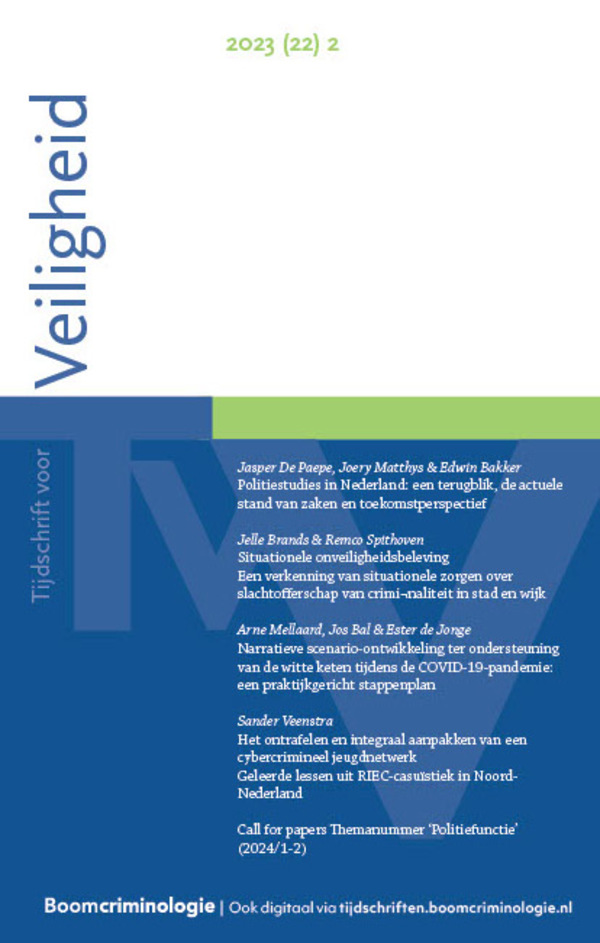|
Nightlife violence is gaining increasing attention and is a substantial part of all violent incidents. In this article we explore the assumption that going out in metropolitan clubs and bars creates a specific moral setting, where the aim is to let yourself go. The main question in this article is to what extent the moral setting of going out contributes to nightlife related violence. We explored this issue by analyzing the case of Amsterdam, in particular the two famous squares, Leidseplein and Rembrandtplein, and de Wallen (red light district). With regard to the moral setting we distinguish between physical, social, professional and normative aspects of the moral setting. Each of these aspects has been described in academic literature as potentially contributing to violence. On that basis a checklist has been developed that was used for observations in nightlife venues that are known for either a high or low disproportionate amount of violent incidents. By comparing the two categories we were able to identify elements of the moral setting which, supported by the literature, can be expected to contribute to the prevalence of nightlife violence. Elements which we discovered that occur more frequently in venues where many incidents occur are visitor density, the loudness of the music, the presence of smokers, the overall comfort, the opportunity to dance, the presence of drunken visitors and their degree of intoxication, overtly sexually charged behavior, opportunities for the staff to observe, security at the exit, the number of bouncers, and whether visitors were searched or not before they entered the venue. Whether situations actually developed into violent conflict depended on one of three possible causes, namely miscommunication, conflict with authority or unsolicited advances. Policymakers can use these insights in order to try to manipulate violence stimulating factors. |


Tijdschrift voor Veiligheid
Over dit tijdschriftMeld u zich hier aan voor de attendering op dit tijdschrift zodat u direct een mail ontvangt als er een nieuw digitaal nummer is verschenen en u de artikelen online kunt lezen.
| Artikel |
Uitgaansgeweld en de morele setting van het uitgaan in Amsterdam |
| Trefwoorden | nightlife, violence, morality, clubs, bars |
| Auteurs | Marco van der Land, Ilse de Groot, Hans Boutellier e.a. |
| SamenvattingAuteursinformatie |
| Artikel |
Aandachtslocaties transportveiligheid in beeld gebracht door combinatie van openbare gegevensbestanden |
| Trefwoorden | transportation safety, big data, hot spots, hazardous materials, congestion |
| Auteurs | Nils Rosmuller en Clemon Tonnaer |
| SamenvattingAuteursinformatie |
|
Safety authorities in The Netherlands have the obligation to develop so-called risk-profiles. Risk profiles are probability-consequences schemes of all kinds of hazards (ranging from earth quakes to transportation and from floodings to fires in high rise buildings). To develop such schemes, various data sources could be useful. In this paper, we describe an approach to make use of existing database to reveal ‘new’ kinds of transportation-related risks. To this end, we combined publicly available public and private databases related to: hazardous materials transportation and Natura 2000 areas; congested areas and large scale public events; hazardous materials transportation and multi-functional areas. |
| Artikel |
Lessons to be learned?De lokale inbedding van de politie in Engeland & Wales en Nederland |
| Trefwoorden | police reform, local embedment of the police, Police and Crime Commissioner (PCC), democracy, citizen involvement |
| Auteurs | Bas van Stokkom, Henk Greven en Hans Boutellier |
| SamenvattingAuteursinformatie |
|
In England & Wales the coalition-government has opted for a localisation of the police service. The government dissociates itself from the New Labour policy of centrally-imposed targets, aims to reconnect the police and the people, and carries out a radical democratic renewal: since 2012 citizens have the possibility to choose their own Police and Crime Commissioner (PCC) in their region. This new administrator is reigning over police chiefs and is responsible for the management of security policies in the region. That is the main reason why the English police reform diverges fundamentally from developments in other European countries in which centralizing tendencies prevail. The question is whether the radical changes in England & Wales have a beneficial impact on the local embedment of the police. Are citizens more willing to commit themselves with the local police? In the first part of this paper we examine which developments have taken place in the English police, what the localisation-agenda has achieved so far, and which problems it faces. In the second part we discuss the question which lessons can be learned from the English renewals. Would it be a good idea to introduce PCC’s in the Netherlands? Is democratization the best way to strengthen community involvement? How to stimulate local accountability? |
| Boekbespreking |
Buurtregie met mate |
| Auteurs | Remco Spithoven |
| Auteursinformatie |
